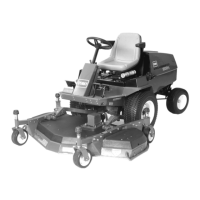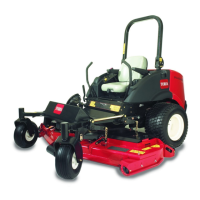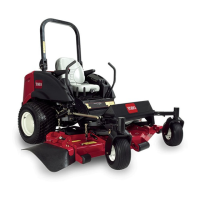29
Adjusting the Steering
1. Measure the toe-in distance (at axle height) at the front
and rear of the steering tires. The front measurement
must be 0–1/4 in. (6 mm) less than the rear
measurement.
2. Loosen the jam nuts and rotate the tie rod to adjust the
clearance (Fig. 33).
3. Turn the steering wheel full left to achieve a full left
turn (Fig. 33).
4. Check the clearance between the left tire and tie rod.
There should be 1 in. (25 mm) ± 1/4 inch (6 mm)
clearance at this position.
5. Loosen the jam nuts and rotate the steering rod to adjust
the clearance (Fig. 33).
6. Rotate the tie rod to move the front of the tire in or out.
7. Tighten the jam nuts when the adjustment is correct.
M–4281
2
1
1
Figure 33
1. Tie rod 2. Steering rod
Changing the Front Axle Oil
After every 500 hours of operation, change oil in the front
axle.
1. Run the machine before changing the oil to warm the
oil. Warm oil flows more freely and carries more
contaminants than cold oil.
2. Clean the area around the drain plug and place a drain
pan below the drain plug on the axle (Fig. 34).
3. Remove the drain plug and allow the oil to flow into the
drain pan (Fig. 34). After the oil is drained, install the
drain plug.
4. Remove the fill plug and fill to the plug level with SAE
EP-90 wt. oil (approximately 14.9cl [44 oz.]) (Fig. 34).
M–4371
2
1
Figure 34
1. Drain plug 2. Fill plug
Servicing the Battery
Battery posts, terminals, and related accessories
contain lead and lead compounds, chemicals
known to the State of California to cause cancer
and reproductive harm. Wash hands after
handling.
Warning
Service Interval/Specification
Check the electrolyte level in the battery every 50 hours.
Always keep the battery clean and fully charged. Use a
paper towel to clean the battery case. If the battery
terminals are corroded, clean them with a solution of four
parts water and one part baking soda. Apply a light coating
of grease to the battery terminals to prevent corrosion.
Voltage: 12 v, 280 Cold Cranking Amps
Checking the Electrolyte Level
1. Raise the seat.
2. With the engine off, open the covers to see into the
cells. The electrolyte must be up to the lower part of the
tube (Fig. 35). Do not allow the electrolyte to get below
the plates. (Fig. 35).
3. If the electrolyte is low, add the required amount of
distilled water; refer to Adding Water to the Battery,
page 30.

